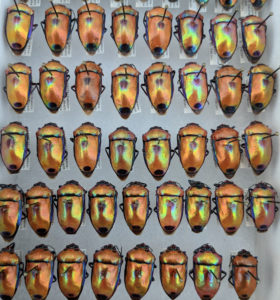Why black Tegula sea snails live where they live is a subject about which naturalists have written tens of thousands of words over the decades. But there is at least one place they live that is far from the bright lights of academic literature: the cold and temperate water tanks at the California Academy of Sciences’ Steinhart Aquarium. Next time you visit the Academy take a right at the entrance, walk to the rainforest dome, and then just as you get there turn around and look behind you at the shallow tidepool area atop the California Coast exhibit. Clinging to those pale pink rocks, washed by a fake tide and overshadowed by the bright green anemones and purple urchins and red bat stars (not to mention the Philippine coral reef and towering tropical rainforest dome) you will see dozens and dozens of small black snails.
The snails are supposed to be there, and in many of the other tanks in the aquarium. They’re accurate ecosystem details in exhibits highlighting the more charismatic sharks and rockfish of the California Coast, but more importantly they’re useful little details, says the Academy’s Assistant Aquarium Curator Seth Wolters. Tegula snails graze on algae and help keep windows clean. “Any kind of help we can have with biological control we use to our advantage as much as possible,” Wolters says. “It’s a win-win.”
In the wild, Tegula sea snails live in well-defined zones — in general smaller, younger black Tegula live in the shallowest areas, then come larger, older black Tegula snails, then brown Tegula in the middle tidal area, and then dusky Tegula and Monterey Tegula in deeper water. Why this pattern exists is complicated, but it raises an interesting question: does the same zonation occur in the artificial environment of the Steinhart Aquarium?
Not sure, Wolters says. Academy curators keep an eye on the snails to see they’re earning their keep by eating up algae. But the primary goal is window maintenance, not scientific study. That said, one of the reasons scientists think black Tegula don’t live in deeper water in the wild is predation by sea stars. The Academy feeds its sea stars, of course, but … well, when it comes to invertebrates, Wolters says, there’s really just no telling them not to eat whatever other convenient food is lying around. “Certainly yes, you will find sea stars on occasion snacking on a snail,” he says. “They do take it on themselves to feed themselves as they go.”
So those snails you see in the shallows behind the rainforest exhibit are doing what wild snails do: climbing onto dry rocks to flee the monsters lurking in the deep. Elsewhere in the Academy you might see evidence of their (probably temporarily) death-defying cousins — tiny grazed trails through the thin layer of algae on the windows. Incidentally yes, Wolters says, they do have to replenish their snail supply. “They lay eggs all over the place, but other animals are picking them off,” he says. “Which is why with the snails we do go out tidepooling and collect them.”
Next time you’re at the Academy, then, take a moment to celebrate the courage of the Tegula sea snails that mow the windows. It’s kind of a snail’s lot in life to be eaten, but these ones at least get to improve your view before they go. And seriously, what’s that long-lived canary rockfish ever done for you except give you nasty looks?
Read lots and lots more about wild Tegula sea snails and why they live where they live in At a Snail’s Place: Answers to the Surprisingly Confounding Question of Why Things Live Where They Live.
Or go find them yourself in a tidepool near you.





